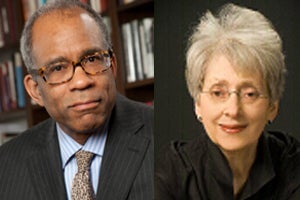On Tuesday, Feb. 14, the Harvard Federalist Society and the Harvard Black Law Students Association co-sponsored a discussion about race and redistricting with Dr. Abigail Thernstrom of the Manhattan Institute and Professor Randall Kennedy, the Michael R. Klein Professor of Law at Harvard Law School.
States must redraw district maps every ten years, and those districts are of crucial importance to political candidates because they want to choose their constituents, Thernstrom said. As politically messy as redistricting is, it is constrained by Section 5 of the Voting Rights Act of 1965. The act gives the Department of Justice the power to review changes that could affect voting when they are implemented by states with a history of discriminatory voting practices.
But federal power to approve changes in electoral procedure to prevent discrimination has been extended to different settings and to groups with no history of exclusion comparable to that experienced by black voters living in the Jim Crow South. Thernstrom said that the effect has been to privilege black and Hispanic incumbents in these jurisdictions protected by Section 5 because their districts cannot be redrawn in such a way as to diminish their electoral prospects, and to create an entitlement for minority legislators to hold office roughly in proportion to their population numbers.
“There was no right to group representation in the American Constitutional order. True political order demands not group rights to representation, but a political system that recognizes citizens as individuals with fluid identities, free to emphasize their racial and ethnic heritage as they wish and to coalesce in any manner they might choose,” she said. “Nevertheless, a less radical statute than the Voting Rights Act could not have solved the deeply seated problem of massive black disenfranchisement in one section of the country. Draconian federal legislation was necessary.”
But enforcement of the Voting Rights Act often ignores contemporary reality, Thernstrom said. For one thing, considerable progress has been made in terms of race relations in the United States, and the mass intimidation and disenfranchisement of black voters that occurred in the 1960s simply doesn’t occur today. Further, neighborhoods, both urban and suburban, have become more racially diverse, so that it would be more difficult today to create districts in which one race is the decisive majority.
And, she said, in safe minority districts, minority candidates are under no pressure to appeal to centrist interests. Very few members of the Congressional Black Caucus have voting records that would attract white support except in reliably liberal, mostly northern, jurisdictions, and very few have experience building biracial coalitions.
“Race-based districts have worked to keep most black legislators clustered together on the sidelines of American political life, and have done precisely the opposite of what the statute intended and precisely the opposite of what is needed,” Thernstrom said.
She said that the civil rights community, too, has come to see the danger of racially gerrymandered districts. The districts are a gift to white Republican candidates, particularly in the South, as they concentrate black voters and drain adjacent districts of black Democrats, enhancing white Republican prospects.
In response, Kennedy agreed with Thernstrom’s point that much progress has been made in terms of combating racism and the mass disenfranchisement of black voters. But while, in light of that progress, Thernstrom questions the continued necessity of Section 5, Kennedy cautioned that she should understand the apprehension that many still have about weakening the Voting Rights Act in any way.
“While there has been a lot of change, one of the agents of that change was the Voting Rights Act,” Kennedy said. “The sounds, the feels, the smells of racial resentment are still part of our political, culture and social environment. So I can well understand the anxiety that is generated by the proposals to change a piece of legislation that has indeed been part of a salutary transformation in American racial life.”
